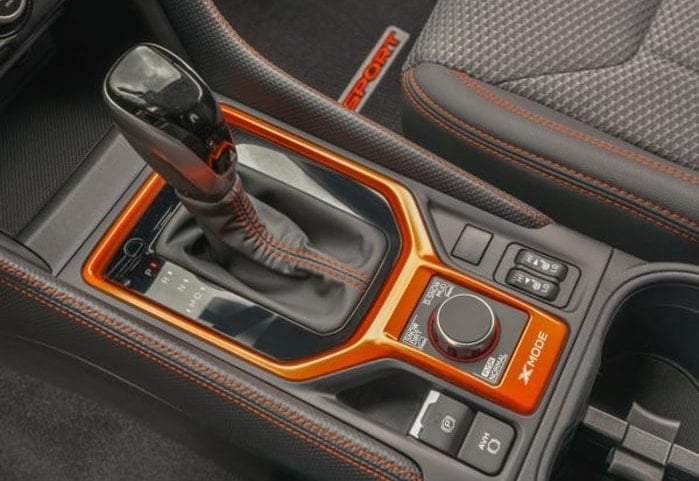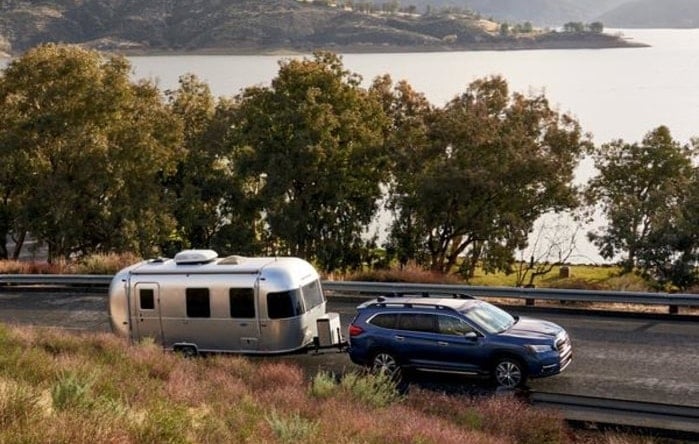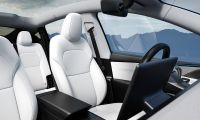Subaru is a brand that has seen impressive growth in the past 10 years, and the Japanese automaker is doing one thing that customers love and another that they dislike with a passion. Subaru’s EyeSight is popular and is getting the brand top safety scores and customers want it. The CVT automatic is a staple in the Subaru stables and some customers loathe it. Why doesn’t Subaru move away from the CVT in the new 2019 Forester, Outback, Crosstrek, and Ascent if customers dislike it?
Subaru uses the Continuously Variable Automatic (CVT) transmission exclusively in their entire lineup of all-wheel-drive vehicles and won’t be dropping it because you have issues with it. They use the 6-speed standard gearbox in their sports cars for driving enthusiasts, but Subaru is committed to the CVT automatic in all their other vehicles and even use it in the sport-tuned WRX and BRZ sport coupe.
Subaru falls in love
Subaru was one of the first automakers to use the CVT. Do you remember the Subaru Justy? In 1989 the Justy became the first production car in the U.S. to offer CVT technology. The Justy was the first car in the world to come equipped with 4WD and ECVT. It was a big thing for Subaru and Justy was the car to introduce the world to the new transmission. Justy with 4WD offered all-weather capability and the new CVT offered fuel efficiency. The two were mated, worked well together and Subaru fell in love with the CVT. 30 years later, they still use a variation of the variable-speed gearbox now called Lineartronic.

Why CVT?
Subaru can get maximum power out of their small four-cylinder Boxer engines allowing for quicker and more responsive acceleration. The CVT is best suited for fuel-efficient city driving and a moderate load which works well in the small all-wheel-drive Forester, Outback, and Crosstrek vehicles. And maybe the biggest reason Subaru is love with the CVT, is because the gearbox is lighter in weight, delivers better power efficiency, and it helps improve a vehicle’s fuel economy over a conventional 6-or-8-speed automatic.
The CVT is ideally-suited for Subaru in their small and medium all-wheel-drive lineup of cars and compact SUVs. Subaru has also made it work well with their 2.0-liter WRX turbo Boxer engine and now coupled with the new 2.4-liter turbocharged Boxer in the larger 2019 Ascent family hauler.
Because there are no gears in a CVT, it allows for manual “shifting.” The belt-and-pulley system moves to preset points that simulate changing gears. This is accomplished by manually clicking the steering-wheel-mounted paddles. The CVT in the new Subaru Ascent SUV comes with paddle shifters and eight of these shift points.

Many customers find the sensation of continuous acceleration without shift points to be unnerving. Another common complaint is that a CVT gearbox tends to make the small SUVs seem excessively loud or harsh. That’s because it forces the engine to run at higher revs as the vehicle gets up to speed. Even if you hate the CVT in the new 2019 Subaru Forester, Outback, Crosstrek and Ascent all-wheel-drive vehicles, Subaru will never leave it.
Watch 2020 Subaru Forester Changes and How Child Lock Reminder Works and Click To Subscribe to Torque News Youtube Channel For Daily News On Subaru and Automotive Industry.
You Might Also Like: Very Few Buy Subaru WRX With EyeSight, Could It Be The Boring CVT Automatic?
Leave your comments below, share the article with friends and tweet it out to your followers! See you in my next story where I am discussing How New 2020 Subaru Ascent Will Work Hard Towing Your Small Camper Or Boat.
Bookmark my Subaru page and be sure to follow the latest new Subaru Forester, Outback, Ascent, Crosstrek reports on Facebook, Twitter, Instagram, Subaru Report. Tweet your Subaru news tips to us @SubaruLegitNews and we'll give you a shout out! Be sure to check back tomorrow for more Subaru news and updates
Photo credit: Timmons Subaru, Subaru USA












Comments
Will the CVT automatic keep
Permalink
Will the CVT automatic keep you from buying a Subaru SUV?
I have an overwhelming hated
Permalink
In reply to Will the CVT automatic keep by Denis Flierl
I have an overwhelming hated for CVTs, so a CVT would keep me from buying any vehicle. I prefer a manual transmission, anyway, and Subaru is about the only manufacturer to offer that along with AWD. As long as that is still an option, I'll keep considering Subaru for new vehicle purchases.
I once had great love for
Permalink
In reply to I have an overwhelming hated by Nick (not verified)
I once had great love for Subaru until they start sticking in CVT transmissions. Wake up Subaru, when medium weight or heavy weight truck makers start sticking them in, and they prove to be long term reliable only then would I buy a vehicle with one. Subaru you are shooting you self in the tail or transmission with this mess; you too Nissan.
I can deal with additional
Permalink
In reply to Will the CVT automatic keep by Denis Flierl
I can deal with additional noise (is that the main complaint?), but reports of early failure are a significant concern.
I'm dealing with this right
Permalink
In reply to I can deal with additional by Matt S (not verified)
I'm dealing with this right now. It's an $8000 repair for a 2014 Forester with 135k miles.
10 year waranty
Permalink
In reply to I'm dealing with this right by Jalaina J (not verified)
10 year waranty
10 year warranty means
Permalink
In reply to 10 year waranty by charles mayer (not verified)
10 year warranty means nothing - you can sell me a brand new pig with a 40 year warranty and it's still apig
I have a 2005 stick-shift
Permalink
In reply to I'm dealing with this right by Jalaina J (not verified)
I have a 2005 stick-shift Toyota Tacoma with 220, 590+ miles on the clock.
Not one problem with the transmission or clutch
Not one.
Have you checked the frame
Permalink
In reply to I have a 2005 stick-shift by David J. (not verified)
Have you checked the frame lately
Have a 2013 Outback with 115k
Permalink
In reply to I'm dealing with this right by Jalaina J (not verified)
Have a 2013 Outback with 115k miles and the CVT is about ready to eat it. Bought it less than 2 years ago @ 93k miles and now I have to buy another car and this one's trade in value is basically $0. I also don't understand why they insist on sticking w CVT and can't find a reliable source to determine if the issue has been solved, or if every CVT I buy has a probability of dropping an $8000 repair bill at 100k miles. They make such great cars, so why sully them with this unreliable tranny.
Agree! Subaru has gotten
Permalink
In reply to Have a 2013 Outback with 115k by Drew (not verified)
Agree! Subaru has gotten themselves in a dilemma... putting out a "Lifetime" - no maintenance (?) Transmission vs Reality that the CVT will not uphold Subie's legendary reliability. By offering extended warranty...all Subaru USA has done is kick the can down the road. Subaru Canada has at least recognized the need to change CVT transmission fluid at 60k. I'm in a pickle... daughter & son in law have a 2018 Outback bought new (30k) and future daughter in law (Navy) has 2015 Forester bought new but not maintained....at 60k+ . Decided to change both CVT fluid this Spring with Subie's CVT fluid via drain & refill. Just FYI I take my role as family mechanic seriously especially with my girls. As a minimum I want 2015 Forester documented by Subaru dealership at 60k for warranty....and if they will change CVT transmission fluid. If not.... I'll do it. Same with 2018 Outback. Where this "lifetime" fluid magic comes from is beyond me!
I'll make this simple. I've
Permalink
In reply to Agree! Subaru has gotten by Martin Radtke (not verified)
I'll make this simple. I've owned two older Subarus and really liked both of them. I wanted a new car last year and would have bought another Subaru, probably without even shopping other makes. The CVT was the only issue. Thanks to that, Mazda sold another new car!
I have the exact same problem
Permalink
In reply to Have a 2013 Outback with 115k by Drew (not verified)
I have the exact same problem. 114K miles and the CVT is a mess. No remedy, no recourse per the dealership. Subaru knows these cars fail and they don’t care. It has greatly affected their reliability rating. No one should be buying used Subarus any more. Not unless they get an $8,000 discount at the time of purchase. Subaru is essentially building disposable cars that are done at 110,000 to 115,000 miles. Hyundai and KIA are now in the running.
Did you put a new tranny in?
Permalink
In reply to I'm dealing with this right by Jalaina J (not verified)
Did you put a new tranny in? This just happened to me. I am looking to put a tranny with 9500 miles into my forester. $2200
It really shouldn't prevent
Permalink
In reply to Will the CVT automatic keep by Denis Flierl
It really shouldn't prevent you from buying a Subaru! I have a 2015 Forester 2.5i Premium. It does just fine, even in the mountains of Colorado. If I had wanted a sports car, I would have bought a sports car! Love my Suby!
Hi Brian, I just purchased a
Permalink
In reply to It really shouldn't prevent by Brian Zimmer (not verified)
Hi Brian, I just purchased a 2018 2.5 premium forester and like the car. But after reading about the cvt failures, I think I should buy and extended warranty to cover the transmission. I have only 19700 miles on this one owner car (One owner car when I purchased. )
Yes the bearings are junk I'm
Permalink
In reply to Will the CVT automatic keep by Denis Flierl
Yes the bearings are junk I'm a transmission shop manager. They start making noise around 80k lots of disappointed people when they find out the dealer wants 5 grand to repair.
If I don't get at least 175
Permalink
In reply to Will the CVT automatic keep by Denis Flierl
If I don't get at least 175,000 out of the CVT I'll be upset... In this day and age, I expect to get 300,000-400,000 miles out of my car... I also don't like how the transmission turns off under very steep, off road situations. . Most CVTs are barely making 110,000, most under...90,000 miles...
Just the opposite. I
Permalink
In reply to Will the CVT automatic keep by Denis Flierl
Just the opposite. I purchased 3 Subarus with manual transmissions, but hen purchased two with the 4 EAT automatic transmission. That conventional automatic was reliable, but the shifting disturbed me, so in 2007 I pleaded with Subaru to bring back the CVT. The response was the 2010 Legacy Outback that featured the CVT in all those models except for the ones with the H6 engine and the units witgh a manual transmission. . I purchased the 2011 Outback with the CVT and was very pleased with it. When the next generation (2015) Outback appeared, ALL US spec Outbacks came with CVT transmissions. -ven the H6 engines were mated to a CVT.
The latest generation Forester followed the same rule. ALL 2019 Forester come with CVT transmissions. No US spec Subaru can be purchased with a conventional automatic transmission.
And guess what? Subaru is selling more vehicles in the US than ever before.
What does that tell you?
How many vehicles are sold
Permalink
In reply to Just the opposite. I by gearhead4 (not verified)
How many vehicles are sold has nothing to do with reliability. That's my concern. I've owned many Subarus, but not currently. I prefer manual transmissions, but have come to terms that modern automatics are more efficient.A CVT would be fine with me. I don't know if Subaru CVT failures are common approaching 200k miles, I was hoping that wasn't the case because I'd like to own a Subaru again some day. The other concern of course are head gaskets. They're now failing on the 2010 and (some) newer models. I was hoping those failures are rare like the CVT troubles, but there seems to be many experiences with head gasket failures (not so much CVT troubles) posted on the Subaru forums. The 4EAT was quite reliable, but made me crazy how soon it downshifted going up a slight grade, The Subaru CVT definitely seems more reliable than the Jatco CVT (Nissan, Jeep Patriot) where failures were very common around 120k miles.
Our 2014 Subaru Impreza CVT
Permalink
In reply to How many vehicles are sold by Steve (not verified)
Our 2014 Subaru Impreza CVT transmission died at 60000 miles.....complete garbage
It tells me they are setting
Permalink
In reply to Just the opposite. I by gearhead4 (not verified)
It tells me they are setting themselves up for huge warranty or class action costs and a steep decline in future sales once all these timebombs detonate. Subaru is selling well (now) because they offer capable AWD sedans/wagons while the rest of the world has gone mad with these POS FWD-based shoebox style CUV's. Subaru is selling well because their older models had very good residual value. These 2 factors got people like me to take a serious look. For myself, a 6MT would be the choice, but for the daughter an automatic is pretty much mandatory right now. The CVT ,the already blossoming problems with head gaskets, oil consumption, and general valvetrain durability, coupled with the high cost of repairs since so many common things are 'engine out' in a subaru have caused me to write off the idea of purchasing any new or used subaru. A lease would be OK, but somehow that high resale value does not translate into attractive lease options, so it looks like used AUDI's or BMW x-drive is the alternative.
Most any maker sells today on the strength of their past models. Some, like GM and Subaru, seem to be destroying their own future with short-sighted grasps at profit today and by skimping on development of new product that will be attractive when tastes shift back to smaller sedans with IC engines. I have serious concerns that the crap makers are pushing onto consumers today will leave a bad taste that results in serious harm to future sales
I had to pay extra for my
Permalink
In reply to Will the CVT automatic keep by Denis Flierl
I had to pay extra for my 2018 Forester with manual transmission I will not buy another because cvt is one of the worst automatics I have ever driven. Mabe it was the demonstrators I drove, but it felt like the cars were struggling. Mabe those transmissions will last in the long haul Mabe not. I keep cars forever so I’m not chancing it My 1995 Legacy wagon is still going strong
“Mabe” is actually spelled
Permalink
In reply to I had to pay extra for my by Fred Forester … (not verified)
“Mabe” is actually spelled with a “y” “ Maybe” is the correct spelling.
Agree with you that I also
Permalink
In reply to I had to pay extra for my by Fred Forester … (not verified)
Agree with you that I also keep my cars for a long time (over 200k miles). I can't afford to keep buying new cars. Long term reliability matters most to me.
Simply too many poor reviews
Permalink
In reply to Will the CVT automatic keep by Denis Flierl
Simply too many poor reviews from experienced motor industry personnel to allow me to consider a Subaru with CVT. Imagine how many Levorg's they would sell if offered with a manual gear box ! Time the senior management at FHi woke up.
I will never buy another
Permalink
In reply to Will the CVT automatic keep by Denis Flierl
I will never buy another subaru
I dont blame...disposable
Permalink
In reply to I will never buy another by John Gorman (not verified)
I dont blame...disposable cars......dont last
No more Subarus in my garage.
Permalink
In reply to Will the CVT automatic keep by Denis Flierl
No more Subarus in my garage. Its a garbage!!
CV transmissions rely on belt
Permalink
In reply to Will the CVT automatic keep by Denis Flierl
CV transmissions rely on belt drive. Never met a belt I liked. Can't buy Subarus for this reason.
Pagination